DIAMOND GUIDE
OUR EXPERT DIAMOND BUYER
HAMISH WHITING
GIA Gemologist and HRD Antwerp Diamond Grader
Hamish Whiting is one of the three founders of our jewellery brand and our in-house Gemologist. Hamish is a highly skilled and very experienced buyer of diamonds and precious gemstones.
Hamish has taken what he has learned during his Gemology and Diamond Grading studies at the GIA in Carlsbad, and the HRD in Antwerp, and further enhanced his buying through his years of experience and extensive research.
He has built a strong network of trusted and ethically responsible suppliers all over the world and purchases all of our gemstones directly. We are very proud to be able to offer Hamish’s skills to our customers.
His passion for what he does is evident if you ever meet him and in the gemstones that we have in our stock.

OUR MODERN CUT DIAMONDS
All of our modern cut diamonds are GIA certified and carefully hand-selected by our GIA Gemologist, Hamish Whiting. Hamish purchases all of our diamonds directly from the largest international diamond Global Sightholders who cut 90% of the world's diamonds. He buys our stock carefully over time with patience and expertise to ensure that we always have a collection of the most high performing and best value diamonds for our customers.
The biggest mistake people make when buying a diamond is buying based on the GIA/diamond certificate alone, also known as “buying blind”. A certificate cannot guarantee whether a diamond is beautiful or not. Even diamonds that look perfect on paper can be unflattering in reality. This is why we go well beyond the GIA certificate to make sure we are offering our customers the most high performing diamonds for the right price, what we call “smart buying”.
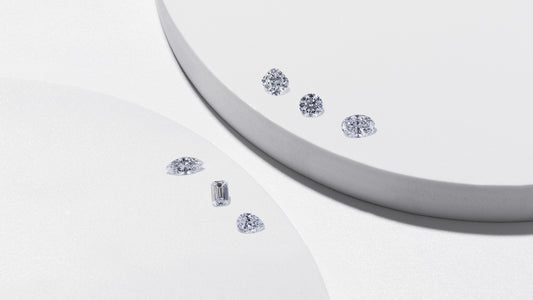
BREAKING DOWN THE 4 C'S
CARAT
- A carat is the measurement of the weight of a diamond, with 1 carat equating to 200 milligrams (0.2 grams).
- The value of a diamond increases exponentially with carat weight due to rarity in larger sizes - doubling the weight can quadruple the price.
- Diamonds of the same carat weight are not necessarily the same face-up millimeter size - this is due to cut quality. Unfortunately, cut quality is often sacrificed to meet consumer demand for “magic number” carat weights i.e. 1 carat, 2 carat.
- In fact, more than 90% of all diamonds are smaller in diameter size than they should be. A smaller diameter means poor light return and less sparkle, as well as a smaller face up appearance.
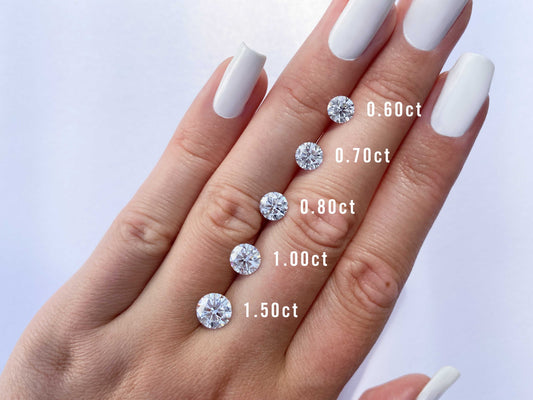
The CW difference
- Our Gemologist only selects diamonds with the very best cut, not only so they are bright and beautiful, but also to ensure that they have the maximum millimetre size for their carat weight.
CUT
Cut quality is the single most important factor in determining a diamond's light performance, beauty and sparkle - however it is also the least understood by diamond purchasers and even diamond retailers.
Cut refers to the angles and proportions of the diamond, which determine how a diamond’s facets interact with light. A well cut diamond will display superior brightness, fire and scintillation compared to one that is not well cut.
A poorly cut diamond will exhibit light leakage in the form of undesirable dark zoning, such as bowties, fish eyes or transparent “windows” through the stone.
The three components of diamond cut which determine a diamonds beauty and sparkle:
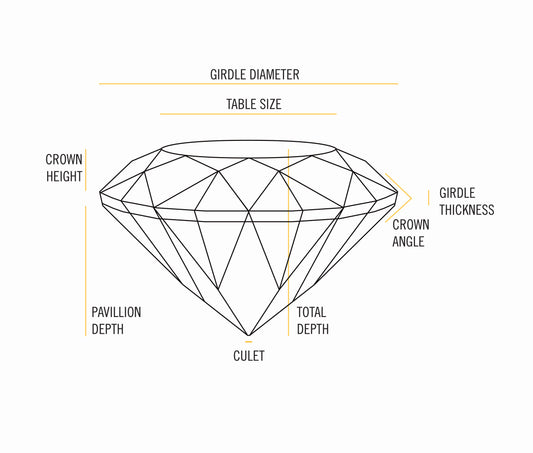
KEY LESSONS
- It is the proportions/angles of a diamond cut that is responsible for brightness and sparkle in a diamond. Cut should NEVER be compromised on.
- The GIA does NOT provide a cut grade report for any diamond shape other than round. The absence of a cut grade on the GIA report for fancy cut diamonds means that there is no incentive for diamond cutters to cut them to ideal proportions, rather they cut them to maximise carat weight and therefore profit.
- The GIA Excellent cut grade for round diamonds is not a guarantee of the visual beauty of a diamond. The GIA’s range of diamond proportions/angles required to meet it’s Excellent cut grade is far too broad. Therefore, two diamonds of the same GIA Excellent cut grade can appear very different to the eye. Even a GIA XXX Triple Excellent Cut diamond does not guarantee optimum brilliance.
- Polish and symmetry are often described as the quality of marksmanship of cutting the diamond, However polish and symmetry are only noticeable to the majority of people in grades lower than good. The difference between the GIA’s Very Good and Excellent symmetry grade is only detectable under a microscope.
- Optical symmetry can have an influence on the symmetry of light return and therefore it’s beauty, however the GIA Excellent symmetry cut grade doesn't guarantee perfect optical symmetry as strangely enough the GIA doesn't measure optical symmetry. To measure the optical symmetry of a diamond we use ASET images.
- The only way to check the cut quality is with your eye (if experienced), or by using a light performance analysis software such as ASET.
THE CW DIFFERENCE
- Our Gemologist Hamish, is extremely particular about diamond cut, buying within very tight parameters for total depth percentage and crown/pavilion angles. Additionally, he will never buy a diamond without first assessing its light return using ASET (Angular Spectrum Evaluation Tool).
- ASET is a software developed by the American Gem Society (AGS) used to analyse the light performance of a diamond from a 3D scan. An ASET light return map visually measures the brightness, contrast and light leakage of a diamond on a computer generated image. Our AGS cut grading software can also give an overall brightness and dispersion grade with zero being the highest possible grade, and 10 the lowest. Using this technology ensures all of our diamonds have beautiful brightness and light performance.
- Our Gemologist buys all of our GIA Excellent cut round diamonds using a much stricter/narrower range of angles, to ensure that they sit at the very top of the GIA Excellent cut grade.
BRILLIANCE/BRIGHTNESS
- A well cut diamond has well angled facets that refract the light back out to the eye of the observer, resulting in what is known as brilliance or brightness. A diamond's brightness is most evident in diffused natural lighting e.g. outdoors in the shade on a sunny day.
- Diamonds that are not well cut can look see-through or dark due to the lack of brightness.
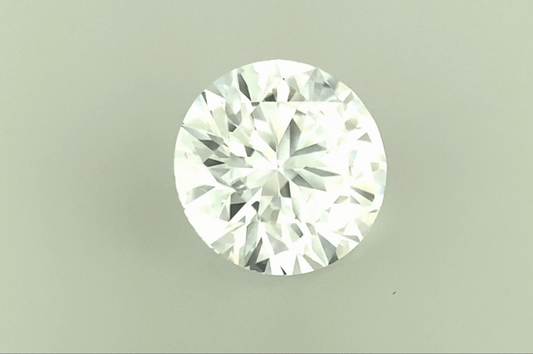
FIRE/DISPERSION
- Fire refers to the flashes of spectral colours (red, orange, yellow, green, blue, and purple) a diamond produces when light exits the diamond’s crown.
- Antique diamonds will show more fire than modern cut diamonds due to having a higher crown and shallower pavilion. Whereas modern cut diamonds are cut to prioritise brightness.
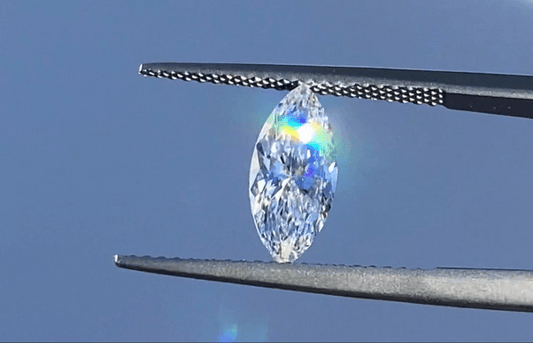
SCINTILLATION/SPARKLE PATTERN
- Different diamond cut styles have different faceting layouts which result in subtle differences in the face-up pattern, symmetry, and the contrast of those sparkling facets. For example, brilliant cut diamonds (ovals, rounds, radiants, pears, marquise) have many small sparkling facets. While step cut diamonds (asscher, emerald, hexagon) have larger broader facets which give fewer but larger reflections of light. It's a question of personal taste whether one likes one or the other.
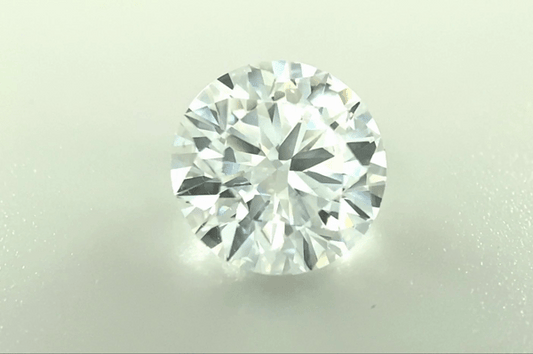
COLOUR
The majority of natural diamonds found in the earth are slightly tinted yellow or brown. Completely colourless diamonds are much more rare and also generally much more desirable for their “icy white” appearance.
The colour scale for diamonds starts at ‘D’ for colourless stones and continues with increasing presence of colour to ‘Z’. Diamonds are exponentially more rare as they have less colour which directly affects the value.
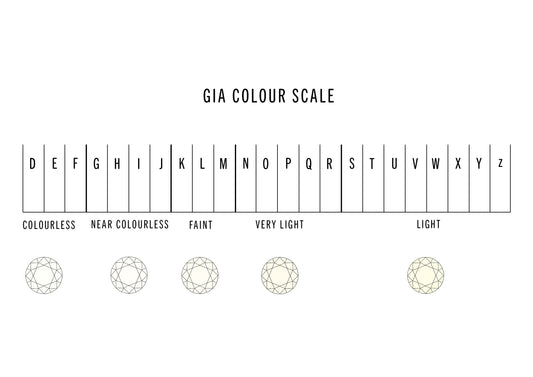
KEY LESSONS
- Between the grades of D to F, colour distinction is so subtle that it is often invisible to the untrained eye.
- A diamond is graded for colour by viewing the diamond upside down (through its pavilion), as when observing a diamond face up, white light reflections will disguise its true body colour.
- In a well cut round diamond, D to G grades will look icy white in most lighting conditions. For all other shapes (fancy cuts) D-F would guarantee an icy white diamond.
- Colour does not determine the beauty of a diamond. A warmer colour, if well cut and eye clean, can be just as beautiful and bright as a high colour grade.
THE CW DIFFERENCE
- For our white diamonds we buy diamonds between the grades D to G for ‘round cuts’ and D to F for ‘fancy cuts’ to ensure that our diamonds are colourless and icy white when face up.
- See more below on how we buy our fancy light yellow diamonds, champagne diamonds and antique diamonds.

CHAMPAGNE DIAMONDS
- A champagne diamond is a type of coloured diamond that’s naturally brown, with a noticeable yellow tint. Each stone has a slightly different hue and tone, some more coppery-brown while others have a more honey/golden hue.
- Champagne diamonds are assessed the same for clarity, cut and carat as white diamonds, however, the colour grading system most often used in the trade is the C1 - C8 grading scale (see diagram). This colour scale is not recognized by the GIA and therefore won't be seen on a GIA grading report for a champagne diamond.
- Champagne diamonds are seldomly certified by the GIA due to the minimal price differences between the champagne range of colours. Whereas, with colourless diamonds there is a significant price difference between the D-E grades particularly in higher carat weights, justifying the cost of certification.
- For this reason it is important to have a trustworthy diamond professional select your champagne diamond to ensure that it is eye clean and well cut with no light loss.
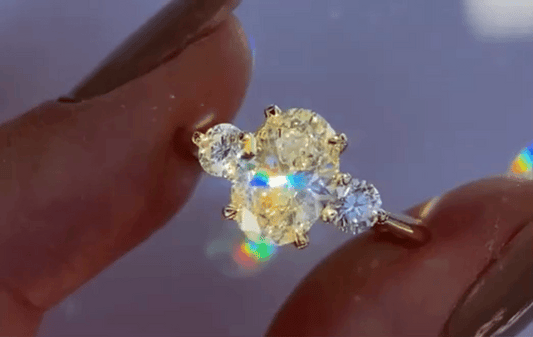
YELLOW DIAMONDS
- Yellow diamonds get their colour through the presence of nitrogen during the formation of the stone. The intensity of the yellow is dependent upon varying amounts of nitrogen. The difference between yellow diamonds and white diamonds is that white diamonds have little to no nitrogen, and therefore do not show colour.
- Diamonds in the GIA D-Z colour range will decrease in value as the colour becomes more obvious. After Z, the Fancy Yellow diamond scale begins.
- In this colour range the diamonds become exponentially more rare and valuable as the colour intensity increases e.g. A Fancy Vivid diamond will be double or more in price per carat after than Fancy Intense yellow grade diamond.
- Fancy coloured yellow diamonds will be GIA certified. This will guarantee that the colour is natural and has not had any treatments such as high heat or pressure to remove any brown hue, and that it is a pure yellow hue.
- Fancy Yellow diamonds are a great middle ground to get a diamond with an overall nice soft yellow colour like a sunflower. Fancy Vivid may be a lot more valuable but that doesn't mean they are necessarily more beautiful.

SALT & PEPPER DIAMONDS
- A salt-and-pepper diamond is a diamond with visible black and white inclusions.
- Because salt and pepper diamonds are much less rare than high clarity white diamonds they are much more affordable. Salt and pepper diamonds do not come GIA certified.
- Every salt and pepper diamond is unique in appearance and can vary from being near white, slightly speckled or light grey, to a cloudy grey, marbled or near black. They can also be lightly speckled but still translucent, or more solid in colour.
CLARITY
Inclusions are natural growth characteristics which occur during the formation process of the diamond deep in the Earth’s crust. Most diamonds will have inclusions. Those that have none or almost none are very rare, and rarity directly affects value.
The GIA clarity scale is a measure of the impact of the inclusions in a diamond when viewed under a loupe at 10x magnification. It ranges from ‘F’ for a flawless stone, right down to ‘I3’ for a stone with very obvious inclusions.
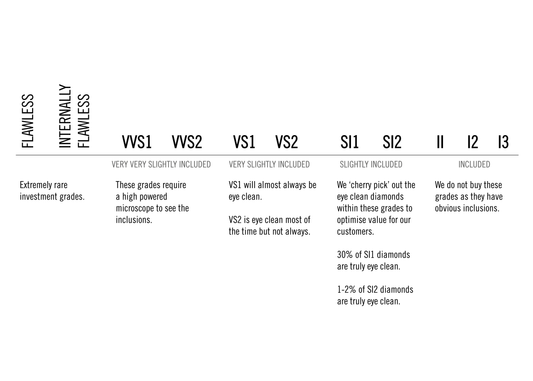
KEY LESSONS
- What is important to us when buying a diamond is that the diamond is 100% eye clean, meaning that there are no no visible inclusions to the naked eye, and no inclusions which will impact the transparency of the diamond crystal.
- You do not need to pay for an incredibly high and rare grade to get a beautiful diamond. VS1 clarity and above requires high powered magnification to see the inclusions, so we don’t normally recommend this grade unless we can balance out the high price with some fluorescence to make the diamond good value.
- The inclusions found in VS- SI diamonds are locatable with a 10x magnification loupe, however many diamonds in this range can have inclusions visible to the naked eye, and that is why a GIA or other grading report alone is insufficient to determine the appearance of a diamond in real life - there can be huge visible differences between diamonds of the same clarity grade.
- It is important for a trained diamond grader to inspect the diamonds in this range and pick out the diamonds that don't have visible inclusions or that negatively impact the diamonds beauty.
- There are many different types of inclusions including feathers, twinning wisps, crystals and clouds, naturals and pinpoints. GIA clarity plots can be very misleading, as the “cleanest” looking plots may not necessarily translate into a better looking diamond when compared to one with a complicated and messy plot. What is important is the type of inclusion(s), and where they are located in the diamond. For example, we don't buy any diamonds with black inclusions, or inclusions which will affect the transparency of the diamond.
- It is a myth that higher clarity diamonds sparkle more. Skillfully chosen diamonds with VS and SI inclusions will sparkle exactly the same way as flawless or VVS graded diamonds of the same cut quality.
THE CW DIFFERENCE
- Unless a specifically high clarity grade is requested, our Gemologist will skillfully select diamonds in the more economical clarity grades for our customers, while ensuring that they are 100% "eye clean" whether they be VS grade or SI grade. This means that there is no eye-visible difference between one of our carefully selected VS-SI diamonds and a flawless diamond. This takes great skill which has been honed over years of diamond buying experience as well as great patience in buying our diamond stock slowly over time .
FLUORESCENCE
Diamond fluorescence is the effect that ultraviolet (UV) light has on a diamond. When you stand under a blue light or ultraviolet light, sometimes you can see your whites get brighter or your teeth appear to glow.
This is the same effect the diamond has under the UV rays. A third of all diamonds glow blue under ultraviolet (UV) light.
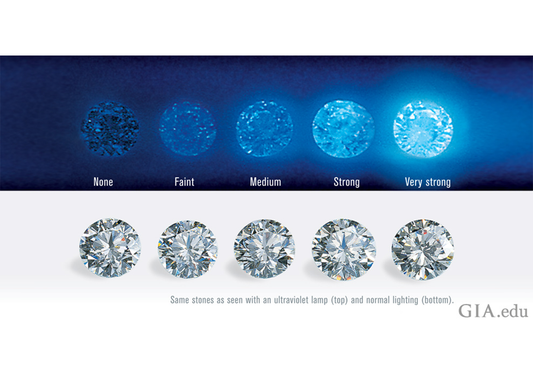
KEY LESSONS
- Fluorescent diamonds are discounted by the trade due to the common misunderstanding by many diamond retailers that fluorescence is a negative thing, or more difficult to sell. International branded jewellers prefer to tell consumers that fluorescence is bad rather than train their staff to recognise the benefits.
- In very rare cases, (less than 0.2%), fluorescence can cause the diamond to have a dull, oily or milky appearance in daylight. However, if screened by a diamond professional, more often than not (98.8% of the time), fluorescence actually improves the appearance of a diamond, or has no effect at all.
- Buying a diamond with medium to strong fluorescence will be approximately 15% to 25% less expensive than a diamond of the same grade without fluorescence, even when it is impossible to distinguish between them.
- People ‘in the know’ buy blue fluorescent diamonds because they appear whiter; and love the fact that they cost a little less.
THE CW DIFFERENCE
- Our Gemologist carefully selects diamonds for our stock with fluorescence that do not have any negative impact on the diamonds visual appearance. Buying diamonds with fluorescence is a very effective way of finding the best value diamonds for our customers.